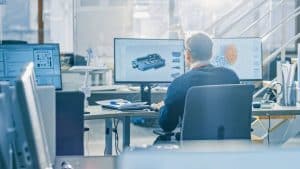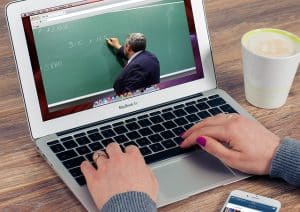Personal Learning Environments, also called PLEs, are getting more popular in schools and colleges. They are a new way of learning that helps students use lots of different educational resources that are available on the internet.
PLEs make it easier for students to keep up to date with all the latest trends in the education sector. PLEs are great because they let students learn in their way. They can pick what they want to learn and how they want to learn it. PLE is a really helpful approach. So, in this article, we will discuss the personal learning environment and also its different aspects.
What is Personal Learning Environment (PLE)?

PLE, short for Personal Learning Environment, is all about creating your own educational space. It’s for your own personal growth and professional growth. In a PLE, you use different online tools and resources.
These tools and resources are in the form of blogs, social media platforms, e-portfolios, and learning management systems. You get to access lots of different things that can help you reach your educational goals and career goals. This way, you’re not just following what others are doing. You’re making your own path in learning.
Evolution of PLEs in Education
The evolution of PLEs in education marks a big change. PLEs came about as an answer to problems with old-school ways of teaching. Before, the learning approach couldn’t meet what each student needed. But now, with the internet, PLEs offer a way to learn that fits each person. This way, you can really get the most from your academic experience.
PLEs are now a big deal in education. Many schools and universities use them. They make learning better for students, especially in online learning environments. Before, students might have felt alone or cut off from others. But PLEs change that. They let students have their own personalized approach. This means students can be in charge of their own learning goals. They feel more connected and can learn easily in a personalized way.
Key Components of a PLE
Key components of a PLE involve various elements that make learning easier and more personal. In a PLE, you have communication tools. These tools let you talk to others and work together on projects. You also find content creation and curation tools. They help you make your own stuff to learn and find relevant things from other places.
There are also assessment tools in a PLE. These are super helpful for keeping an eye on how you’re doing and checking what you’ve learned. Plus, there are resource organization and management tools. They are organized and easy to find.
All these parts of a PLE let you connect, collaborate, share, curate, track progress, evaluate, organize, and manage your learning. It’s like having a toolbox for your education. You get to grow both personally and professionally.
Benefits of Personal Learning Environments

Personal Learning Environments offer great benefits like customization and flexibility. Students get a personalized learning experience according to their goals and styles. PLEs provide tools and resources that fit each student’s habits and pace. This means students can learn on their own terms, making the experience both fulfilling and effective. For instance, if you prefer visual aids, you can use mind-mapping software. If you prefer listening, audio-based learning with podcasts or audiobooks could be your thing.
Autonomy is another big plus. PLEs let students take charge of their learning. They set their own schedules and goals and track progress. This leads to self-awareness and self-directed learning. If you’re struggling with something, you can find extra help through your PLE. This boosts motivation and engagement.
Collaboration and communication get better, too. PLEs help students and educators work together, even over long distances. Social networking and video conferencing tools mean you can work on projects with others, getting real-time feedback and support.
Lastly, the organization in this process is smoother. You can have a digital notebook for notes, assignments, and reminders. This helps with productivity and time management
Also Read: What is Courseware?
Challenges of Personal Learning Environment
PLE brings the biggest challenge: learners need to be really active in their learning process. If you’re used to just listening to teachers, this new way might be hard. Also, all the technology in PLEs can feel very difficult to handle, especially if it’s new to you.
Also, using lots of technology in PLEs can make you get distracted. There’s also a chance for miscommunication.
To help with these issues, educators need to support and guide students. They can help students stay focused and communicate effectively. This way, students can get the most out of their PLEs.
Also Read: Bespoke eLearning
How To Create a Personal Learning Environment?
Creating a PLE is pretty easy. You can do it with different online tools and resources. First, think about what you want to learn. These are your learning goals. Then, look for stuff that can help you learn. It could be online courses, educational videos, or other educational resources.
Once you know your goals and what resources you need, you start creating your PLE. You could make an e-portfolio. This is like a collection of all your work and learning. Or set up a blog or social media platform. These let you write about what you’re learning and share it with others. Another best thing to use is learning management systems. There are various learning management systems available; some of the most popular are Kajabi, Clickfunnels, and thinkific. These systems help keep everything you’re learning in one place.
What Tools and Resources Are Available to Help You Do So?
Lots of tools and resources can help you create a PLE. Popular ones include Canvas, Google Classroom, and Blackboard. These platforms make it easier to organize and access learning materials. There are also online communities and resources focused on helping students. They offer guidance for developing and maintaining your Personal Learning Environment. This support makes it easier to customize your learning experience to your needs.
Implementing PLEs in Educational Settings
Integrating PLEs with Learning Management Systems (LMS) is very beneficial. LMS helps manage the main parts of PLEs, like collaborative tools and administrative functions. Having all the important resources and modules sorted makes managing student work easier.
Encouraging Student-Centered Learning is important in PLEs. They give students tools to control their own learning. Supporting Diverse Learning Styles and Needs is another part of PLEs. Students learn in different ways. With so much info online, PLEs give them lots of ways to learn. This makes learning better for everyone.
Final Thoughts
PLEs are a popular approach to learning. Many institutions all over the world are using them now. They’re changing how we teach and learn. These PLEs bring lots of benefits. When teachers and students use PLEs well, they really make learning better. This shows how educators and students can do more with the right tools and services. So, we can now say that in the education industry, PLE is a game changer.






